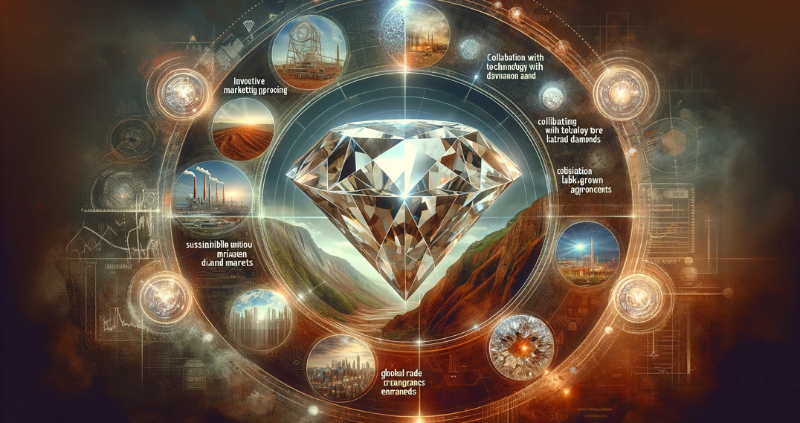Navigating the Shifting Sands: Effective Strategies for the Declining Natural Diamond Market
The natural diamond market has long been a symbol of luxury and exclusivity. However, recent trends have shown a decline in the prices of natural diamonds, raising concerns and prompting a reevaluation of strategies within the industry.

The natural diamond market has long been a symbol of luxury and exclusivity. However, recent trends have shown a decline in the prices of natural diamonds, raising concerns and prompting a reevaluation of strategies within the industry. This article delves into the dynamics of the diamond market, exploring the reasons behind the falling prices and offering sustainable solutions for businesses to thrive in this changing landscape.
How is the Natural Diamond Market Controlled?
The natural diamond market has historically been controlled by a few key players who managed the supply to maintain price stability. Companies like De Beers once had a significant influence, dictating prices through controlled releases of diamonds from their extensive stockpiles. However, the scenario is changing with the emergence of new mining companies and the growing popularity of lab-grown diamonds, leading to a more fragmented and competitive market.
Why is the Price of Natural Diamonds Dropping?
Several factors contribute to the declining prices of natural diamonds:
1.Increased Supply: New mining operations in Canada, Russia, and Africa have increased the supply of natural diamonds, leading to a surplus in the market.
2.Competition from Lab-Grown Diamonds: Technological advancements have made lab-grown diamonds more accessible and appealing to consumers, offering a less expensive alternative to natural diamonds.
3.Changing Consumer Preferences: Millennials and Gen Z consumers are increasingly valuing sustainability and ethical sourcing, often preferring lab-grown diamonds or other alternatives.
Sustainable Strategies for the Diamond Industry
In the face of falling natural diamond prices and shifting market dynamics, the diamond industry must adopt sustainable strategies that not only address current challenges but also pave the way for future growth. These strategies should encompass both operational sustainability and innovative marketing approaches.
1.Transparency and Ethical Sourcing:
Blockchain Technology: Implementing blockchain technology can enhance transparency in the diamond supply chain. By tracking the journey of a diamond from the mine to the consumer, blockchain ensures authenticity and ethical sourcing, which is increasingly valued by consumers.
Certifications and Standards: Adhering to internationally recognized certifications like the Kimberley Process can help in assuring consumers of the ethical origins of diamonds.
2.Embracing Technology in Operations:
Advanced Mining Techniques: Utilizing AI and IoT in mining operations can lead to more efficient and environmentally friendly extraction processes.
Automated Sorting and Grading: Implementing automated systems for sorting and grading diamonds can reduce operational costs and improve accuracy.
3.Targeted Marketing:
Storytelling: Crafting compelling stories around the uniqueness and ethical sourcing of natural diamonds can create emotional connections with consumers.
Influencer Partnerships: Collaborating with influencers who resonate with target demographics can enhance brand visibility and appeal.
4.Digital Marketing Strategies for the Diamond Industry
In today's digital age, effective online marketing strategies are crucial for reaching and engaging with consumers:
1.Content Marketing:
Educational Content: Creating informative content about diamond quality, care, and the ethical sourcing process can position your brand as a trusted authority.
Blogging: Regular blog posts on topics like the latest trends in diamond jewellery or tips for choosing the perfect diamond can drive organic traffic to your website.
2.Social Media Marketing:
Platform-Specific Strategies: Utilize platforms like Instagram for visual storytelling and Facebook for community building and customer engagement.
User-Generated Content: Encourage customers to share their experiences and photos with your products, enhancing authenticity and trust.
3.Search Engine Optimization (SEO):
Keyword Optimization: Use relevant keywords in your website content to improve search engine rankings and visibility.
Local SEO: Optimize for local search queries to attract customers to physical stores or local online platforms.
4.Email Marketing:
Personalized Campaigns: Send personalized emails based on customer preferences and previous purchases.
Newsletters: Regular newsletters with exclusive offers, new arrivals, and educational content can keep your brand top-of-mind.
5.Online Advertising:
Targeted Ads: Use platforms like Google Ads and social media advertising to target specific demographics and interests.
Retargeting Campaigns: Implement retargeting to re-engage visitors who have shown interest in your products but haven't made a purchase.
By integrating these sustainable operational and digital marketing strategies, the diamond industry can not only navigate the current market challenges but also build a foundation for long-term success and growth.
The natural diamond industry is at a crossroads, facing challenges from various fronts. However, by understanding the market dynamics and implementing strategic changes, businesses can navigate these challenges effectively. Embracing sustainability, technological advancements, and innovative marketing strategies will be key to thriving in this evolving market.
For more insights and resources on navigating the diamond industry, visit GA Demand App, your comprehensive guide to understanding and succeeding in the diamond business.
Join GA Demands for key strategies in "Navigating the Shifting Sands: Effective Strategies for the Declining Natural Diamond Market." Stay ahead in the evolving diamond industry with our expert guidance.

